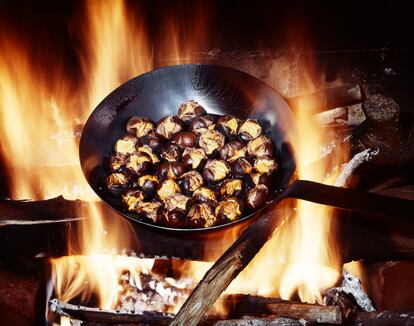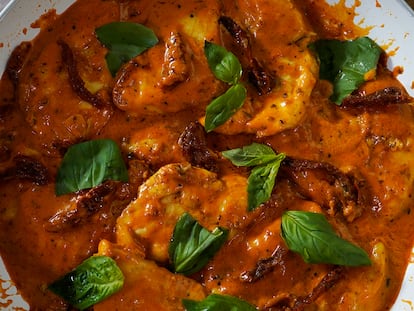How a recipe brought the cast-iron skillet back into style
This year the sales of this pan, perfect for sealing meat, have risen more than 40 percent compared to 2010

A recipe can go viral for different reasons and, when it does, can also bring into fashion the paraphernalia with which it is made. Such is the case with the Dutch baby, a colorful dish located halfway between the crêpe and the pancake, only in the shape of a bowl, which can be filled with sweet or savory ingredients and which, around 2012, brought back a profound love for cast-iron skillets, which had fallen into disuse at the time. Every time someone cooks a Dutch baby in one of these pans, they rack up the views, like in this case:
They say that the history of this recipe was born in confusion. A restaurant in Seattle called Manca’s Café began to make them and baptized them Dutch, when in reality they were looking for the word Deutsch, due to the babies having come from a German recipe. Nonetheless, Ken Albala, in Pancake: A Global History (Reaktion Books, 2008) writes that the first recipes for the unique pancakes were Dutch: the 1514 recipe book Een Notabel boecxken van cokeryen already mentioned panckoecken, and in 1667′s De Verstandige Kock, a total of three versions are detailed.
The trick to Dutch babies’ raised edges is the steam generated by a very hot pan, well-greased with butter. When working with such an airy batter, contact with a burning-hot surface will cause the air inside it to quickly escape and lift the batter as it cooks. Cast-iron skillets are a key factor in successfully making the dish. Pastry chef Joanna Artieda says that, “The recipe is not complicated and be easily made in a restaurant or at home. It is a versatile, original and creative way of eating a stuffed pastry.”
Griswold, Wagner, Blacklock Foundry and Lodge were the three main companies that supplied the American public with cast-iron skillets from the late 19th century until well into the 20th. The skillets were inexpensive, could last for generations, were versatile (they can also be put inside the oven), distributed heat evenly and retained it for a long time. They marked the evolution of the frying pans with legs that were once placed directly onto embers. Moreover, at a time when meat consumption was not as common as it is today, cast-iron skillets transferred a considerable amount of iron to the food cooked in them.
The pans had begun to fall into oblivion by the 1970s. Heavy and in need of special care (they have to be cured before use, cleaned delicately with salt or mild soaps, and protected from rust by applying a coat of oil after each use), they were replaced by light, practical alternatives coated with Teflon or other non-stick materials that prevented food from irretrievably sticking to their bottoms. Nevertheless, they remained popular in the South, where they are used to fry chicken and make cornbread.
The return of the venerable frying pans is evident from their continually increasing sales: compared to 2010, according to data portal Statista, sales this year have increased by 41.48 percent. Meanwhile, the internet’s interest in the skillets is extraordinary: on Reddit, a message board dedicated to the pans (r/castiron) is one of the most visited on the web, with more than a half-million users and constant activity. Their Google Trends search history is also remarkable: from 2010 to date, searches are always increasing, have never fallen, and had their biggest jump in May 2020, amidst lockdown.
Love for these old pans is couched in what trend experts call nowstalgia: “At a time when hedonism dominates the spirit of our age, when culture has been accelerated by social networks and their algorithms, which have killed 20-year cultural cycles, nowstalgia embraces the chaos of internet culture, of all eras, as if they were happening all at once, and gives them a futuristic twist. It looks to the past to build new presents,” states the website Death to Stock. Of course, today the cast-iron skillet’s appearance is considered aesthetic, for its robustness, durability, simple lines and the material from which it is made. It evokes a craftsmanship and a longed-for past from which we yearn to learn how to cook more slowly and to eat better, dovetailing with one of the food movements whose message has had a major impact on the way we consume: slow food.
On the other hand, the cast-iron skillet is associated with masculinity, and the new interest among men in taking on cooking as a competitive sport. Why? Because this pan, heavy and dark, requires mastery of both the skillet and oneself, akin to a motorcycle or shotgun. Not to mention the fact that, in addition to the aforementioned Dutch baby, there are other recipes in whose elaboration the cast-iron skillet is exceptional, including the sealing of thick pieces of meat, a product that is still perceived culturally as a masculine taste. In fact, one of the cast-iron skillet’s greatest moments came at the hands of Brad Leone, a chef who was a member of the Bon Appétit cast at one of the publication’s high-water marks, in a video in which he explains how to cure it.
Sign up for our weekly newsletter to get more English-language news coverage from EL PAÍS USA Edition
Tu suscripción se está usando en otro dispositivo
¿Quieres añadir otro usuario a tu suscripción?
Si continúas leyendo en este dispositivo, no se podrá leer en el otro.
FlechaTu suscripción se está usando en otro dispositivo y solo puedes acceder a EL PAÍS desde un dispositivo a la vez.
Si quieres compartir tu cuenta, cambia tu suscripción a la modalidad Premium, así podrás añadir otro usuario. Cada uno accederá con su propia cuenta de email, lo que os permitirá personalizar vuestra experiencia en EL PAÍS.
¿Tienes una suscripción de empresa? Accede aquí para contratar más cuentas.
En el caso de no saber quién está usando tu cuenta, te recomendamos cambiar tu contraseña aquí.
Si decides continuar compartiendo tu cuenta, este mensaje se mostrará en tu dispositivo y en el de la otra persona que está usando tu cuenta de forma indefinida, afectando a tu experiencia de lectura. Puedes consultar aquí los términos y condiciones de la suscripción digital.
More information
Últimas noticias
Most viewed
- Reinhard Genzel, Nobel laureate in physics: ‘One-minute videos will never give you the truth’
- Oona Chaplin: ‘I told James Cameron that I was living in a treehouse and starting a permaculture project with a friend’
- Pablo Escobar’s hippos: A serious environmental problem, 40 years on
- Charles Dubouloz, mountaineering star, retires at 36 with a farewell tour inspired by Walter Bonatti
- Why we lost the habit of sleeping in two segments and how that changed our sense of time










































